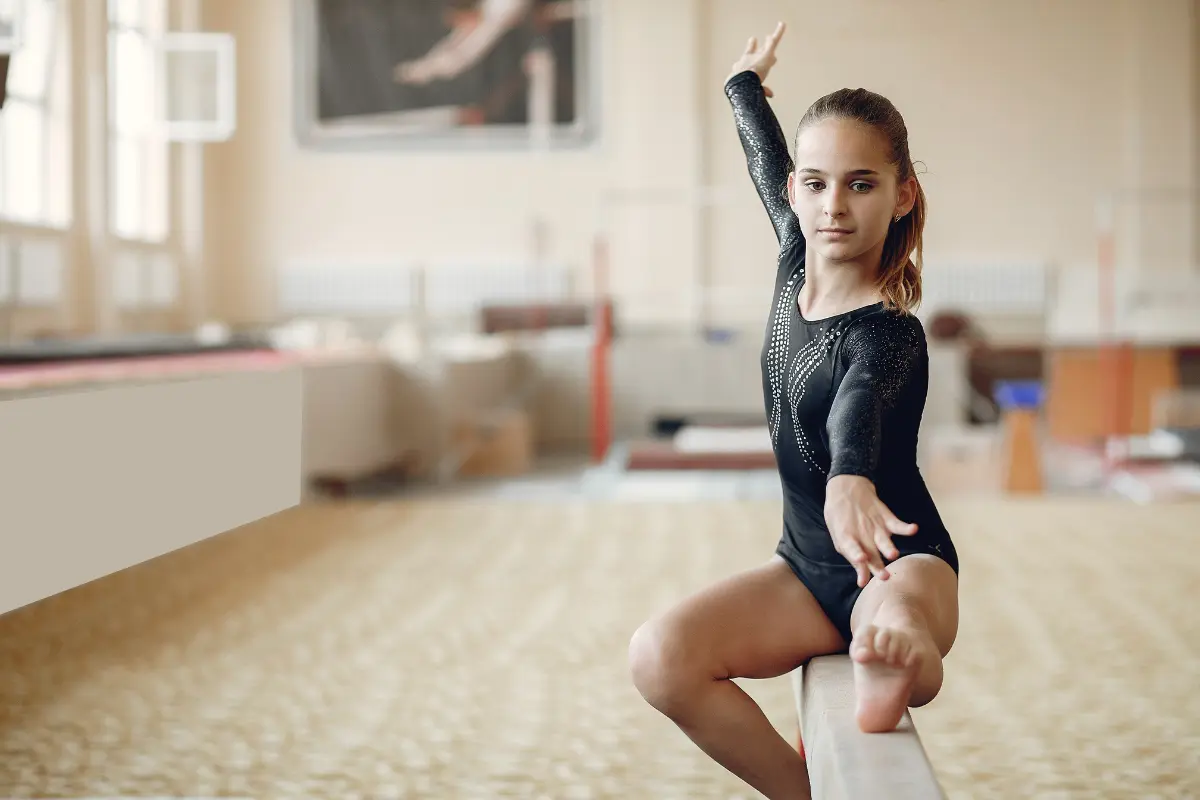The wolf turn has recently become a standout move in gymnastics. It gained significant attention during the Tokyo Olympics, particularly thanks to athletes like Simone Biles. While it might appear deceptively simple at first glance, the wolf turn is one of the most challenging skills.
What Is the Wolf Turn?
At its core, the wolf turn is a spin, but it’s not just any spin. This move starts in a low squat position, with one leg extended and the other tucked close to the body. From there, the gymnast spins around the supporting leg while keeping the tucked leg in place. The key to this move is staying compact throughout the rotation, with the chest facing forward and the arms winding up for the spin.
The wolf turn is distinct from other gymnastics spins because of the position of the tucked leg and the low starting squat. The gymnast has to rotate fully, completing one or more turns, before smoothly transitioning to the next move or landing.
It can be broken down into four main movements:
- Starting Position: The gymnast begins in a squat position on the balance beam or floor, with one leg stretched out.
- Arm Movement: She extends her arms and winds them up in preparation for the spin.
- Spinning: Once balanced, she begins to spin.
- Stopping: Finally, she stops the spin and returns to her original stance, all while maintaining perfect balance to avoid falling.
The skill looks simple, but there’s a lot more going on than meets the eye. Executing these four steps flawlessly requires a delicate balance of mass and inertia—a combination that makes the Wolf Turn exceptionally difficult.
The Physics and Strength Behind the Wolf Turn
The Wolf Turn is one of those gymnastics skills that looks almost magical when executed well. For gymnasts, it’s not just about spinning; it’s about managing their body in ways that seem impossible.
The Physics of the Wolf Turn
David Young, a physics professor at Louisiana State University who’s studied sports mechanics, explains that the Wolf Turn relies on a gymnast’s ability to control her center of mass—basically, how her body’s weight is distributed—while spinning.
When a gymnast like Simone Biles gets into the crouched position to start the Wolf Turn, most of her body’s mass is in her torso. To stay balanced, her center of mass has to stay right above her point of support—usually her foot. If she leans too far back or gets off balance, she risks falling. But once she begins spinning, the way she distributes her body mass changes, and this is where things get interesting.
Here’s how it works: The gymnast’s “moment of inertia” changes as she moves. This is a fancy term for how the gymnast’s body mass is spread out to her axis of rotation—the center point around which she spins.
When she pulls her arms in close to her body, she reduces her moment of inertia. This makes it easier and faster for her to spin. When it’s time to slow down, she extends her arms outward. This increases her moment of inertia, which makes it harder to spin, helping her stop the turn quickly and with control.
It’s pretty amazing when you think about it: the gymnast is consciously shifting the way her body moves through space to control her speed and stop the spin, all while staying balanced and centered. That’s the physics behind it.
The Strength Required for the Wolf Turn
Of course, all that physics wouldn’t matter if the gymnast didn’t have the strength to pull it off. The Wolf Turn takes a huge amount of physical power. Gymnasts need their arms, shoulders, legs, and core to work together in perfect harmony to stay in control throughout the movement.
The arms play a big role in controlling the speed of the turn. When they’re pulled in close, the gymnast spins faster. When they’re extended, the gymnast slows down. But it’s not just about the arms; the legs and core provide the stability and strength needed to hold that low squat position at the start and maintain the control needed to keep everything aligned while spinning.
Executing the Wolf Turn isn’t just about muscle; it’s about coordination and timing. The gymnast needs to be able to engage multiple muscle groups at once, keep her body balanced, and make sure the spin is smooth and precise.
Incorporating the Wolf Turn Into Gymnastics Routines
The Wolf Turn is one of those skills that stands out in a gymnastics routine—unique, challenging, and impressive when executed well.
Why Gymnasts Love the Wolf Turn
For gymnasts, the Wolf Turn isn’t just a cool move; it’s a way to rack up valuable difficulty points. A Wolf Turn, particularly a triple rotation, boosts the difficulty level of a routine, helping gymnasts push their scores higher.
The International Gymnastics Federation (FIG) includes the Wolf Turn in its Code of Points. According to the Code, the skill can be performed with one, two, or three rotations, with difficulty increasing based on the number of rotations completed.
- Single Wolf Turn: Rated as a C-level element.
- Double Wolf Turn: Rated as a D-level element.
- Triple Wolf Turn: Rated as an E-level element.
Beyond the points, the Wolf Turn also serves an artistic purpose. When a gymnast nails the turn, it adds an elegant yet powerful moment that makes the routine feel more polished and exciting.
The Wolf Turn on the Balance Beam
The balance beam is one of the most challenging places to perform the Wolf Turn due to the narrow surface and need for absolute control. The compact nature of the spin makes the Wolf Turn a perfect fit for the beam, where gymnasts must work within a limited space. However, the risk of falling is higher on the beam, and even the smallest shift in balance can lead to a deduction or a fall.
When performed correctly on the beam, the Wolf Turn can serve as a defining moment in the routine. Gymnasts often combine it with other elements, like jumps, leaps, or acrobatic moves, to create a dynamic and engaging routine. The key is to perform the Wolf Turn with smoothness and precision—if done well, it can be one of the most captivating parts of the routine.
The Wolf Turn on Floor Routines
On the floor, the Wolf Turn is often used as part of a sequence of spins or as a transition between more acrobatic elements. The additional space of the floor gives gymnasts a little more freedom to execute the spin with speed and power, making it less confined than on the beam. However, the technique still demands the same level of control and balance.
The Wolf Turn’s unique aesthetic also plays a big role in floor routines, where artistry is just as important as execution. Whether paired with tumbling passes or other spins, the Wolf Turn enhances the visual appeal of the floor routine and adds an extra layer of complexity.
Conclusion
Incorporating the Wolf Turn into a gymnastics routine is a smart way for athletes to elevate their performance. It adds both difficulty and artistry, making the routine more dynamic and memorable. When executed with precision, it becomes a striking element that truly defines a gymnast’s routine.













